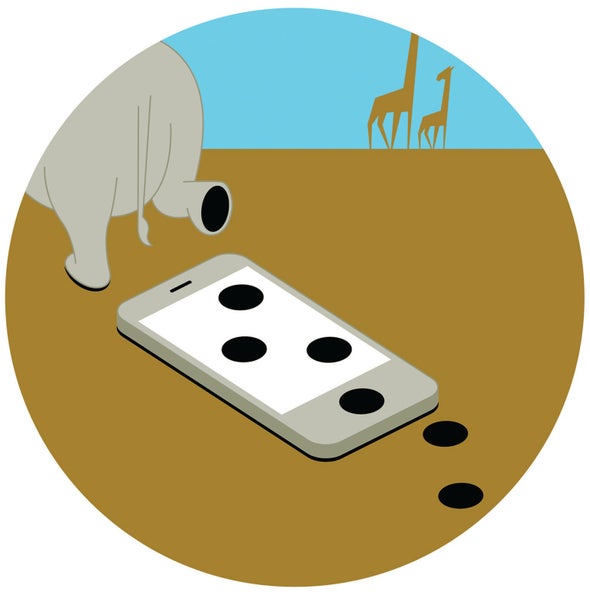International demand for black rhinoceros horn has seen the animals killed relentlessly for decades in countries such as Namibia, Zimbabwe and South Africa. In 1960 there were an estimated 100,000 left, and by 1995 fewer than 2,500 remained. Conservation efforts have brought the number up to around 5,600 today—but the species is still critically endangered, and poaching is among its biggest threats.
Scientists have worked to protect these rare creatures by tracking them with GPS devices strapped to their necks or ankles or implanted in their horns. The resulting data let researchers monitor the rhinos' numbers and when they enter poaching hotspots. But the devices can fail, and drugging the animals to attach them may cause harm.
A recent study in PeerJ describes a new tracking technology that uses smartphones to record rhino footprints. Called the footprint-identification technique (FIT), this system includes software that can analyze the animals' movements from a distance to help keep them safe from poachers.
The idea came from working with local trackers in Zimbabwe. These footprint-reading experts can identify individual black rhinos from the shape of their feet and, when visible, the impressions left by cracks in the animals' heel pads, which are as distinctive as a human fingerprint. “We probably wouldn't even have looked at the footprints in the first place if we didn't have Indigenous trackers,” says Sky Alibhai, co-founder of conservation organization WildTrack and study co-lead.
To use the system, scientists gather rhino footprint images with a smartphone application and upload the pictures to a global database. FIT software analysis can then identify the individual animal and determine its age and sex with up to 99 percent accuracy. Researchers can also estimate the number of black rhinos in an area and watch their movements.
Alibhai and Zoe Jewell, WildTrack co-founder and study co-lead, are training wildlife conservationists, land managers, local guides and antipoaching agents to use FIT in Namibia, home to about 28 percent of the world's black rhinos. Since the paper's publication, researchers have adapted the technology for diverse animals, including African lions, Bengal tigers and Eurasian otters.
“I think this is great for monitoring animals and counting individuals,” says Ciska Scheijen, a conservation scientist at Rockwood Conservation in South Africa, who was not part of the study. Scheijen wonders about FIT's performance during the rainy season, when footprints are often indistinct, and if it can track larger herds as opposed to the 35-odd individuals this study monitored.
Endangered animals often live in small groups or are sparsely distributed, Jewell says, but “FIT is scalable, and we would always welcome the opportunity to use it with endangered species that are in larger populations.”

